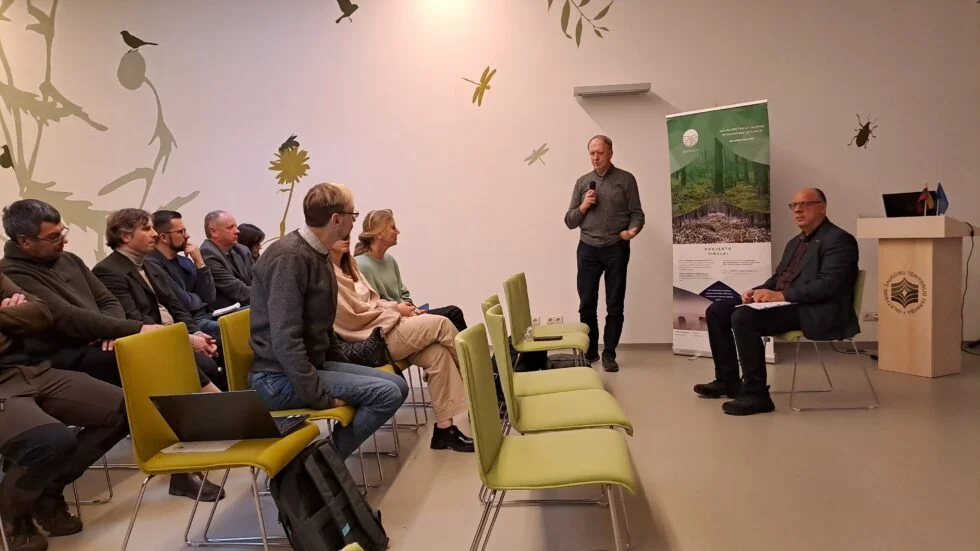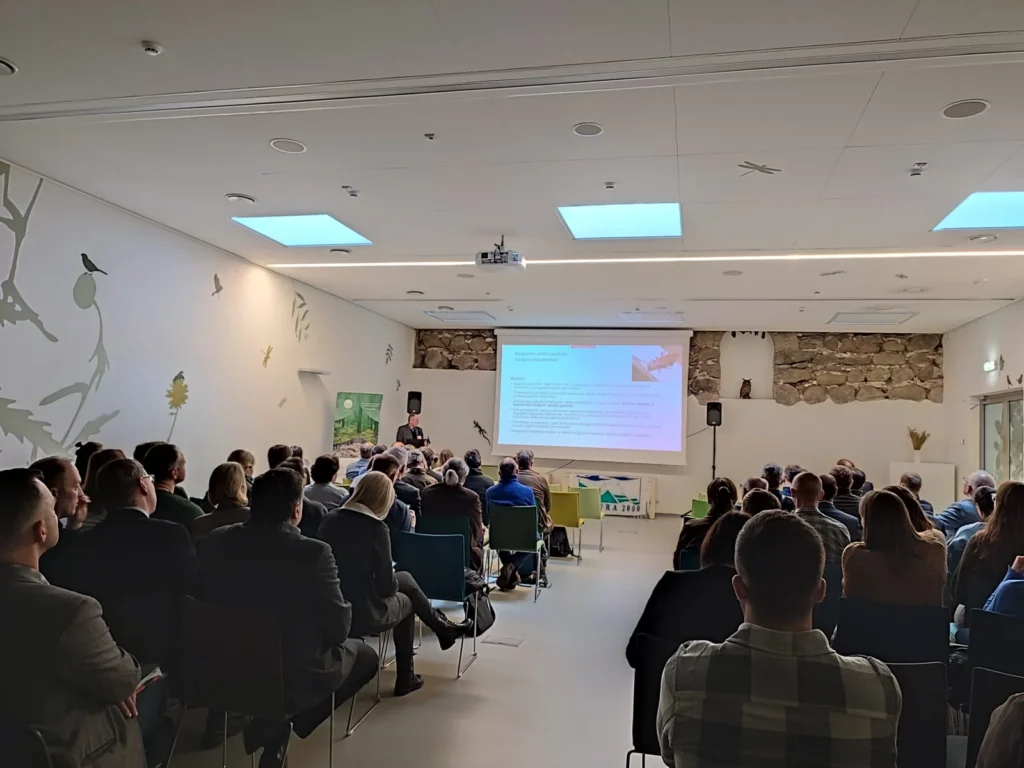
Photo: Saulius Dragūnas
On 22 November, scientists from Vytautas Magnus University (VMU) presented the updated recommendations for the management of natural forest habitats of European Community (EC) importance in the BBSF. The presenters presented the recommendations and updates on the management of forest species’ habitats developed within the framework of the Natura 2000 project, related to clear-cutting, criteria for assessing the good status of habitats, and sanitary logging.
The Recommendations for the Management of SSSIs for Natural Forest Habitats of EC Importance (the “Recommendations”) were first presented in 2021. They are designed to protect the most valuable forest habitats in Lithuania, while allowing for certain economic activities, with exceptions. As a result of the failure to find a suitable solution to integrate the Recommendations into the National Forest Agreement and the growing need to start farming differently in the EC’s important natural forest habitats, preserving the values and improving the structure of the habitats, the Recommendations have been modified and supplemented.
Changes are urgently needed
Nerijus Kupstaitis, Head of the Forest Policy Group of the Ministry of the Environment, welcomed the presentation at the National Visitor Centre of the State Service for Protected Areas. He welcomed the audience’s great interest in the Recommendations and the discussion on their implementation.
“I would like to underline that we need change, and we needed it yesterday”, said Kupstaitis. He said that changes in forest policy have been discussed for several years, but they are not easy: “These are responsible decisions. It is difficult to correct a mistake, so it is necessary to weigh up the decisions, to have a solid scientific basis, to have evidence from studies”.
The Head of the Forest Policy Group of the Ministry of the Environment expressed the Ministry’s position that the recommendations will soon be put into practice.
The recommendations for the management of natural forest habitats in SSSIs have been supplemented, without minor amendments, by expanded recommendations for the implementation of development and sanitary logging. This was presented at the event by Prof. Gediminas Brazaitis of the Faculty of Forestry and Ecology of the VMU Academy of Agriculture (VMU) and Silvija Šaudyte-Manton, a nature conservationist.

Photo: Saulius Dragūnas
According to Prof. Gediminas Brazaitis, in order to create stands with higher structural diversity in younger stands in natural forest habitats and protected areas, variable density thinning is recommended. This creates a larger stand mosaic consisting of areas untouched by development harvesting (10-15% of the area), open cavities (10-15%) and traditionally developed areas (up to 75%), leaving a greater diversity of species and tree development classes. Small densities of 0.1-0.3 ha where species requiring specific environmental conditions are present or expected, small wetlands, game cave sites, etc. are not managed.
“The cavities are also created in areas where rare species require better light conditions, by opening up the crowns of valuable trees, or to achieve spontaneous regeneration and thus a diverse stand structure. This type of coppicing has been applied in the Czech Republic, the USA and is being tested in Scandinavian countries,” the professor said. – “Sanitary felling is a sensitive topic in protected areas because protected values can easily be damaged. However, it is important to carry out prompt protection of spruce budworms by barking or removing dangerous trees. Without delay in sanitation, such trees are rendered non-threatening or even useful by the pest parasites they harbour and should therefore be protected for their biodiversity value.
When large amounts of deadwood are generated, some of it may be removed from the habitat for economic purposes, as large amounts of one type of deadwood do not add value to the species associated with the deadwood, which is important to ensure the long-term existence of a wide range of deadwood types and sufficient quantities in the protected area.
The audience was interested in how a “win-win” situation can be achieved, avoiding the loss of the stand and at the same time improving conditions for biodiversity. They also touched upon the issue of replanting in highly thinned plots due to tree mortality.

Photo: Saulius Dragūnas
Presented the criteria for habitat assessment
Vytautas Uselis, a nature conservation expert and botanist at the Methodological Analytical Centre of the State Service for Protected Territories, pointed out that the initial version of the Recommendations for 2019-2020 was based on more general principles of the structure of natural forest habitats of EC importance, and on the conservation needs. More detailed guidance on what good condition habitats should look like was being developed for 2020-2023.
In the Sites of Importance for Habitat Conservation (SITs) adopted during this period, the requirements for Good Conservation Status (GCS) were introduced alongside the conservation objectives. Until then, habitats were assessed on an expert basis, with a category of good, fair, poor or potential condition. The development of detailed criteria for assessing the status of habitats (GABs) allows for a more objective assessment of the status of habitats and provides clearer guidance for the implementation of the Recommendations.
In the presentation “Criteria for assessing good habitat condition and their integration into the Recommendations”, experts presented the criteria for assessing habitats, which have been refined after field trials. The audience was introduced to their structure, the principle of their functioning within the overall protection framework of the Natura 2000 network, and examples of the BHCs for individual habitat types were presented. The second part of the presentation highlighted some aspects of the harmonisation of these documents and discussed the integration of the habitat assessment criteria for the HCVs into the guidelines for the management of EC SSSIs.
“The forest habitat assessment criteria presented during the event will allow the status of habitats to be determined using specific, measurable, clear parameters and will enable monitoring of changes in status. The updated Guidance document, which will serve to ensure, restore or create good condition of habitats, must be harmonised and be in line with the objective of the BCC good value indicators”, – stated S. Šaudytė-Manton.
The event also discussed the EC Habitats Directive recommendations for the management of forest species habitats. Dr Žydrūnas Preikša, a lecturer at the Faculty of Forestry and Ecology of VMU ŽŪA, presented them and discussed the choice of habitats for the species, the threats and the proposed conservation and management measures that could be useful for the preparation of nature management plans or for the protection of the species in specific sites. The scientist noted that some species have been little studied scientifically and therefore protection and management measures for their habitats cannot yet be proposed.
Funded by the European Union LIFE programme. The contents of this publication are the sole responsibility of and do not necessarily reflect the opinion of the European Union.
